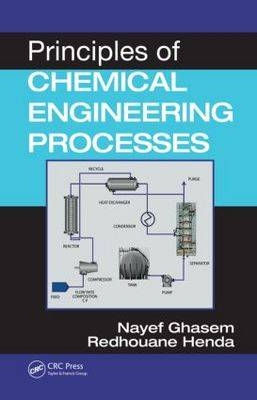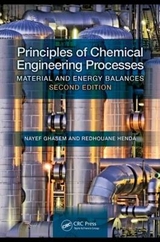
Principles of Chemical Engineering Processes
Crc Press Inc (Verlag)
978-1-4200-8013-1 (ISBN)
- Titel erscheint in neuer Auflage
- Artikel merken
Written in a clear, concise style, Principles of Chemical Engineering Processes provides an introduction to the basic principles and calculation techniques that are fundamental to the field. The text focuses on problems in material and energy balances in relation to chemical reactors and introduces software that employs numerical methods to solve these problems.
Upon mastery of this material, readers will be able to:
Understand basic processing terminology (batch, semibatch, continuous, purge, and recycle) and standard operations (reaction, distillation, absorption, extraction, and filtration)
Draw and fully label a flowchart for a given process description
Choose a convenient basis for calculation for both single- and multiple-unit processes
Identify possible subsystems for which material and energy balances might be written
Perform a degree of freedom analysis for the overall system and each possible subsystem, formulating the appropriate material and energy balance equations
Apply the first law of thermodynamics, calculate energy and enthalpy changes, and construct energy balances on closed and open systems
Written as a text to fully meet the needs of advanced undergraduate students, it is also suitable as a reference for chemical engineers with its wide coverage across the biochemical and electromechanical fields. Each chapter of the text provides examples, case studies, and end-of-chapter problems, and the accompanying CD-ROM contains software designed for solving problems in chemical engineering.
UAE University, Al-Ain, United Arab Emirates Laurentian University, Sudbury, Ontario, Canada
Introduction
At the End of This Chapter You Should Be Able to
Definition of Chemical Engineering
Material and Energy Balances
Values, Units, and Dimensions
Systems of Units
Unit Conversion
Time
Mass
Length
Volume
Density
Force
Pressure
Energy
Power
Weight
Dimensional Homogeneity
Significant Figures
Multiplication and Division
Addition and Subtraction
Process and Process Variables
Density, Mass, and Volume
Flow Rate
Moles and Molecular Weight
Mass Fraction and Mole Fraction
Concentration
Pressure
Types of Pressure
Manometers for Pressure and DP Measurement
Temperature Measurement
Converting Temperatures
Ideal Gas Law
Standard Temperature and Pressure
Process Classification
Problems
Process Classification
Types of Processes
Unit Conversion
Flowrate through Horizontal Pipe
Molar Flow Rate
Dimensional Homogeneity
Calculation of Mass for Specific Gravity and Volume
Convert of Equation to Other Units
Further Readings
Process Units and Degrees of Freedom Analysis
At the End of This Chapter You Should Be Able to
Degree of Freedom Analysis
Possible Outcomes of the DFA
Sources of Equations
Process Units: Basic Functions
Divider=Splitter
Mixer (Blender)
Dryer (Direct Heating)
Filter
Distillation Column
Evaporator
Dehumidification
Humidifier
Leaching and Extraction
Absorption (Gas Absorption) Desorption
Partial Condenser
Flash Vaporizer and Flash Distillation
Crystallizer
Reactors (Chemical Reactor, Combustor, Furnace, and Reformer)
Batch Reactor
Plug Flow and Packed Bed Reactor
Continuous Stirred Tank Reactor and Fluidized Bed Reactor
Summary of Degree of Freedom Analysis
Problems
Absorption of Acetone from Air
Separation of Liquid Mixture
Absorber–Stripper Process
Filtration Processes
Evaporation Processes
Further Readings
Material Balance in Single Unit Processes
At the End of This Chapter You Should Be Able to
General Material Balance Equation
Material Balance Simplifications
Flowcharts
Note on Notation
Problems Involving Material Balances on a Single Unit
Material Balance Fundamentals
Classification of Processes
Based on How the Process Varies with Time
Based on How the Process was Designed to Operate
Types of Balances
Stream Specifications
Scaling
Basis for Calculation
Basis for Calculation
Method for Solving Material Balance Problems
Material Balance on Bioprocesses
Problems
Separation of Ethanol–Methanol Process Stream
Wet Leather Drying Process
Separation of Ethanol–Methanol–Propanol Mixture
Ethanol–Water Separation
Mixing of Hydrochloric Acid with Water
Removal of Acetone from Nitrogen Using an Absorber
Separation of Benzene=Toluene Mixture
Dilution of Methanol Mixture
Humidification Chamber
Absorption of Water from a Gas Mixture
Drying of Wet Sugar
Further Readings
Multiple-Unit Process Calculations
At the End of This Chapter You Should Be Able to
Multiple-Unit Process Calculations
Recycle, Bypass, Makeup, and Purge
Recycle
Bypass
Purge
Makeup
Problems
Separations of Benzene, Toluene, Xylene Mixtures
Filtration Processes
Concentration of Orange Juice
Separation of NaCl and KCl Mixture
Sulfur Removal System
Separation of DMF–Nitrogen Mixture
Separation of Benzene–Toluene Mixture
Separation of Potassium Nitrate
Production of Instant Coffee
Further Readings
Material Balances in Reactive Processes
At the End of This Chapter You Should Be Able to
Amount of Substance in Moles
Why Use the Mole?
General Material Balance
Differential Balance
Integral Balance
Stoichiometry Basics
Stoichiometric Equation
Stoichiometric Coefficients (ni)
Stoichiometric Ratio
Limiting and Excess Reactants
Fractional Conversion
Methods of Solving Material Balances Involving Chemical Reactions
Extent of Reaction Method
Element or Atomic Balance Method
Molecular or Component Balance Approach
Multiple Reactions and Extent of Reaction
Degree of Freedom Analysis for Reactive Processes
Molecular Species Balances and Extent of Reaction
Atomic Species Balances
Independent Chemical Reactions
Independent Species Balances
Chemical Equilibrium
Combustion Reactions
Theoretical and Excess Air
Problems
Incomplete Combustion of Butane
Complete Combustion of Butane
Methane Combustion
Burning Ethyl Ketone with Excess Air
Roasting of Iron Pyrite
Water–Gas Shift Reaction
Production of Sulfuric Acid
Further Readings
Multiple Systems Involve Reaction, Recycle, and Purge
At the End of This Chapter You Should Be Able to
Reaction with Product Separation and Recycle
Reaction with Recycle and Purge
Flowsheet for Reaction with Recycle
Flowsheet for Reaction with Recycle and Purge
Reaction and Multiple-Unit Steady-State Processes
Auxiliary Relationship
Problems
Chemical Reactor Analysis
Laundry Detergent Synthesis Process
Butanol Production
Hydrodealkylation Process
Uranium and Zirconium as Nuclear Fuels
Further Readings
Energy Balance without Reaction
At the End of This Chapter You Should Be Able to
Enthalpy and Energy Balances
How Does Energy Move Across Systems?
Forms of Energy
Kinetic Energy (Ek)
Potential Energy (Ep)
Internal Energy (U)
Intensive versus Extensive Variables
Transfer of Energy
First Law of Thermodynamics
Energy Balances on Closed Systems
Possible Simplifications on Energy Balance in a Closed System
Energy Balances in Open Systems at Steady State
Possible Simplifications on Energy Balance in an Open System
Enthalpy Calculations
Reference States and State Properties
Use of Linear Interpolation in Steam Tables
Enthalpy Change in Nonreactive Processes
Enthalpy Change as a Result of Temperature Change
Enthalpy Change because of Phase Changes
Enthalpy Change because of Mixing
Energy Balance on Bioprocesses
Psychrometric Chart
Summary on Energy Balances without Reactions
Problems
Vaporization of Liquid Methanol
Heating of Propane
Expansion of Wet Steam
Open System Energy Balance (Heating of Methanol)
Open System Energy Balance (Heating of Liquid Methanol)
Vaporization of Liquid n-Hexane
Closed System Energy Balance (Heating of Acetone)
Open System Energy Balance (Power Output of Turbine)
Open System Energy Balance (Power Requirement of Compressor)
Further Readings
Energy Balances with Reaction
At the End of This Chapter You Should Be Able to
Introduction
Heats of Reaction
Heats of Reaction Using the Extent of Reaction
Notes on Heats of Reaction
Reactions in Closed Processes
Measurement of Heats of Reaction
Hess’s Law
Calculating Heat of Reaction () from Heats of Formation
Calculating D Hr from Heats of Combustion
Energy Balances on Reactive Processes
Heat of Reaction Method
Heat of Formation Method: Process Path
General Procedure for Energy Balances with Reaction
Processes with Unknown Outlet Conditions
Energy Balances in Bioprocess
Problems
Estimation of Heat of Reaction
Production of Superheated Steam
Ammonia Synthesis Process
Catalytic Transalkylation of Toluene to Benzene
Combustion of Methane
Anaerobic Yeast Fermentation
Further Readings
Combined Material and Energy Balances
At the End of This Chapter You Should Be Able to
Material Balances
Conversion
Yield
Selectivity
Extent of Reaction ()
Energy Balances
Heat of Reaction Method
Heat of Formation Method
Concept of Atomic Balances
Mathematical Formulation of the Atom Balance
Degree of Freedom Analysis for the Atom Balance
Implementing Recycle on the Separation Process
Problems
Mixing of Hot and Cold Ethanol
Combustion of Acetylene
Dehydrogenation of Ethanol
Independent Chemical Reaction
Cumene Synthesizes Process
Dehydrogenation of Propane
Further Readings
Unsteady-State Material and Energy Balances
At the End of This Chapter You Should Be Able to
Unsteady-State Material Balance
Unsteady-State Energy Balance
Problems
Fluid Flow from Storage Tank
Boiling of Water
Heating Using Saturated Steam
Heating a Solvent in a Stirred Tank
Concentration of Reactant as a Function of Time
Further Readings
Appendix
Index
| Erscheint lt. Verlag | 11.9.2008 |
|---|---|
| Zusatzinfo | 500 equations; 57 Tables, black and white; 220 Illustrations, black and white |
| Verlagsort | Bosa Roca |
| Sprache | englisch |
| Maße | 156 x 234 mm |
| Gewicht | 703 g |
| Themenwelt | Naturwissenschaften ► Chemie ► Technische Chemie |
| Technik | |
| ISBN-10 | 1-4200-8013-X / 142008013X |
| ISBN-13 | 978-1-4200-8013-1 / 9781420080131 |
| Zustand | Neuware |
| Haben Sie eine Frage zum Produkt? |
aus dem Bereich



